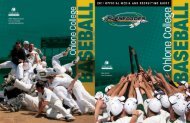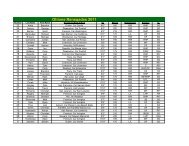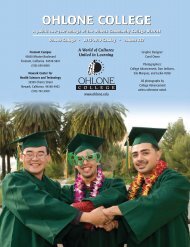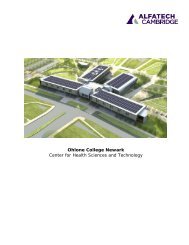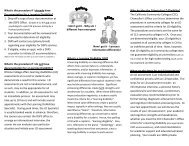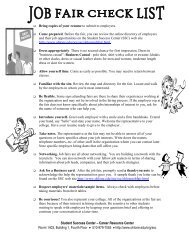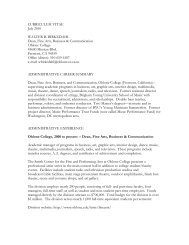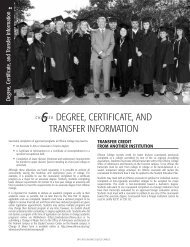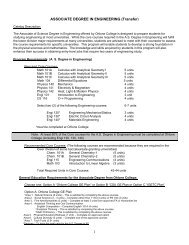2012-2013 Catalog (all pages) - Ohlone College
2012-2013 Catalog (all pages) - Ohlone College
2012-2013 Catalog (all pages) - Ohlone College
Create successful ePaper yourself
Turn your PDF publications into a flip-book with our unique Google optimized e-Paper software.
164 9 ANNOUNCEMENT OF COURSES<br />
CNET-114<br />
CNET-115<br />
CNET-116<br />
CNET-120<br />
How Technology Works<br />
54.00 hrs lecture, 54.00 hrs lab<br />
Units: 4.00<br />
Cross-referenced Course: ENGI-114<br />
Accepted For Credit: CSU<br />
This course is intended for students of <strong>all</strong> disciplines who are<br />
interested in how everyday things work. It is an introduction to<br />
some of the fundamental science concepts underpinning high<br />
technology, emphasizing everyday devices and practical<br />
experience, for the development of scientific and computer<br />
literacy. Students will experiment with technology to discover<br />
principles of science. Concepts such as force, work, energy,<br />
power, liquids and gasses, heat transfer, electricity, magnetism,<br />
electronics, light, materials science, and time are explored<br />
through experimentation and observation. Students will<br />
experience through class demonstrations and hands-on<br />
laboratories the concepts presented by the instructor.<br />
Phenomena such as how computers convert data, how iPods<br />
transmit sound, how electronic thermometers measure<br />
temperature, how solar heating panels capture heat, and how<br />
GPSs use microwaves will be explored. Field trips to local tech<br />
industry displays are required. (GC)<br />
Introduction to Robotics and Automated Systems<br />
54.00 hrs lecture, 54.00 hrs lab<br />
Units: 4.00<br />
Cross-referenced Course: ENGI-135<br />
Accepted For Credit: CSU<br />
Students who take this class will understand how scientific<br />
innovation can affect their lives either directly or indirectly. The<br />
class will teach students the principles of scientific<br />
methodology as it is applied to solving problems. The<br />
application of this scientific method will be used to navigate an<br />
abundance of technical information—to obtain the information,<br />
to understand the information, and to determine how to apply<br />
it. This course describes the functional hardware and software<br />
components of automated systems. The student will<br />
experience how scientific principles are applied by building<br />
and programming robots. The emphasis is for students to learn<br />
science by actu<strong>all</strong>y doing science. Repeatable = 3 times (GC)<br />
Introduction to Programming Using Robotics<br />
54.00 hrs lecture, 54.00 hrs lab<br />
Units: 4.00<br />
Accepted For Credit: CSU<br />
This course is designed to teach the beginning programmer<br />
how code programs using robots. Emphasis will be placed on<br />
basic Java programming concepts and skills. A “Create” robot<br />
from iRobot is used by the student to exercise their new<br />
programming skills. The student will have the opportunity to<br />
extend the mechanical functionality of the base robot and<br />
program sensors they attach to the robot. (GR)<br />
VMware: Inst<strong>all</strong>, Configure, Manage<br />
27.00 hrs lecture, 27.00 hrs lab<br />
Units: 2.00<br />
Accepted For Credit: CSU<br />
This hands-on training course explores inst<strong>all</strong>ation,<br />
configuration, and management of VMware ® vSphere, which<br />
consists of VMware ESXi/ESX and VMware vCenter Server.<br />
Upon completion of this course students can take the<br />
examination to become a VMware Certified Professional. The<br />
course is based on ESXi 4.0, ESX 4.0, and vCenter Server 4.0.<br />
Repeatable = 3 times (GC)<br />
CNET-135 Database Fundamentals I:<br />
Database Architecture and Administration<br />
27.00 hrs lecture, 27.00 hrs lab<br />
Units: 2.00<br />
Advisory: Knowledge of SQL or knowledge of a programming<br />
language<br />
Accepted For Credit: CSU<br />
In this course students learn to startup and shutdown a<br />
database, create a database, manage file and database storage,<br />
and manage users and their privileges. In addition, students<br />
learn to organize the database and to move data into and<br />
between databases. Hands-on practices help to reinforce key<br />
concepts and students have an opportunity to troubleshoot<br />
real life issues when they are given examples of typical<br />
problems encountered when operating an Oracle database.<br />
(GC)<br />
CNET-136 Database Fundamentals II:<br />
Database Backup and Recovery<br />
27.00 hrs lecture, 27.00 hrs lab<br />
Units: 2.00<br />
Accepted For Credit: CSU<br />
This course addresses backup and recovery techniques and<br />
examines various backup, failure, restore, and recovery<br />
scenarios for current versions of Oracle databases. Participants<br />
utilize multiple strategies and Oracle tools such as Recovery<br />
Manager to perform backups and restore and recovery<br />
operations. Participants have the opportunity to apply some of<br />
the more advanced techniques within a workshop<br />
environment. In addition to lecture and hands-on learning, this<br />
course addresses answers to frequently asked questions<br />
concerning backup and recovery. Repeatable = 2 times (GC)<br />
CNET-137 Introduction to SQL<br />
54.00 hrs lecture, 54.00 hrs lab<br />
Units: 4.00<br />
Cross-referenced Course: CS-137<br />
Accepted For Credit: CSU<br />
This course covers the concepts of relational databases and<br />
powerful SQL. Students are taught to create and maintain<br />
database objects and to store, retrieve, and manipulate data.<br />
Demonstrations and hands-on practice reinforce the<br />
fundamental concepts. (GC)<br />
CNET-138 PL/SQL Programming<br />
54.00 hrs lecture, 54.00 hrs lab<br />
Units: 4.00<br />
Prerequisite: CS-137 or CNET-137<br />
Accepted For Credit: CSU<br />
Students learn to program in PL/SQL and understand the use<br />
of this programming language. Students learn to create<br />
PL/SQL blocks of application code that can be used by forms<br />
and reports. Students learn to create procedures, functions,<br />
packages, to manage dependencies, to manipulate large<br />
objects and built-in packages. Repeatable = 2 times (GC)<br />
CNET-140A Linux Inst<strong>all</strong>ation and Configuration<br />
27.00 hrs lecture, 27.00 hrs lab<br />
Units: 2.00<br />
Prerequisite: CNET-150; CS-146 or CNET-146<br />
Accepted For Credit: CSU<br />
This course introduces the functions and features of the Linux<br />
operating system including the file system, system services,<br />
processes, background processing, scheduling, and security.<br />
The course supplies students with the information they need<br />
to inst<strong>all</strong> and configure Linux on a personal computer.<br />
Students will get practical experience in inst<strong>all</strong>ing,<br />
administering, and troubleshooting Linux systems. This course<br />
is preparation for Sair Linux and GNU certification. Repeatable<br />
= 3 times (GC)<br />
<strong>2012</strong>-<strong>2013</strong> OHLONE COLLEGE CATALOG





